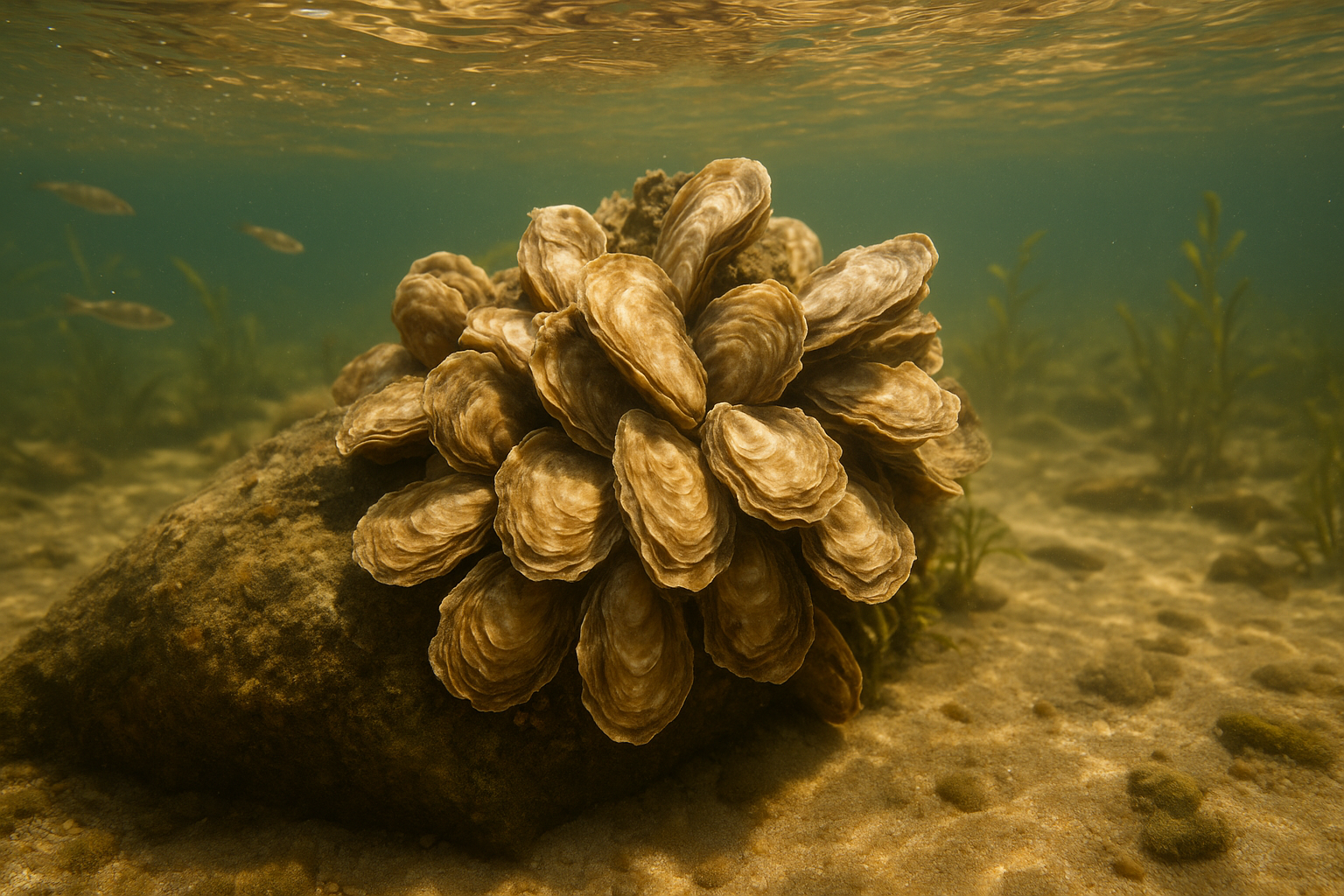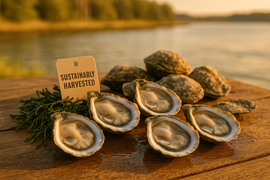Oysters are nature’s water purifiers, filtering up to 50 gallons of water daily per oyster. They remove excess nutrients, sediments, and pollutants, improving water clarity and supporting aquatic ecosystems. Despite only 1% of the original oyster population remaining in the Chesapeake Bay, restoration and modern farming methods are helping revive their vital role in cleaning Virginia’s waterways.
Key Facts:
- Filtration Power: 1 oyster = 50 gallons/day.
- Ecosystem Benefits: Reduced nitrogen, clearer water, and habitats for 300+ species.
- Economic Impact: Virginia’s oyster industry contributes over $30 million annually.
- Restoration Efforts: 11 rivers in Virginia targeted for oyster population recovery by 2025.
Oyster restoration and sustainable farming are proving to be cost-effective ways to clean water and boost biodiversity. Support these efforts by recycling oyster shells, backing local farms, or joining restoration programs.
Oyster Filtration
The Science of Oyster Water Filtration
Oysters are nature's water cleaners, equipped with a biological filtration system that’s nothing short of extraordinary. These mollusks play a crucial role in improving the quality of water in Virginia's rivers by removing suspended particles through their unique internal processes.
Inside an Oyster's Gills
Oyster gills are lined with tiny, hair-like structures called cilia, which act like natural sieves to filter water. These microscopic projections are arranged in channels that maximize contact with passing water, ensuring efficient filtration[5]. The process kicks off when an oyster opens its shell and pumps water through its gills. As the water flows, the cilia work to separate solid and semi-solid particles from the liquid[5][6].
How Oysters Trap Particles
Once water passes through the gills, the particles get caught in a sticky mucus coating. This mucus is key to capturing a variety of materials, such as:
| Particle Type | Filtering Action |
|---|---|
| Plankton | Trapped and consumed as food |
| Algae | Captured and processed |
| Sediments | Filtered and removed |
| Excess nutrients | Extracted from the water |
The nutritious particles are directed to the oyster's digestive system, while unwanted debris is bundled into "pseudofeces" and expelled[2]. These expelled materials, along with regular feces, settle on the riverbed as biodeposits, further contributing to the natural cleaning process[5].
Water Filtering Capacity
Matthew Gray, a scientist at the University of Maryland Center for Environmental Science, explains the impact of oysters: "When conditions are optimal, they can really have transformative effects on water quality and clarity"[1]. However, their filtration efficiency depends on several factors, including temperature, water salinity, turbidity, food availability, and the presence of harmful algae blooms. For instance, their filtering ability decreases in very cold or extremely hot temperatures[1].
Under ideal conditions, a single adult oyster can filter around 5 liters (1.3 gallons) of water per hour - amounting to an impressive 50 gallons daily[1][4][6]. Restored oyster reefs, like those in Harris Creek, Maryland, have shown the power of these natural filters. During summer months, these reefs can clean the creek’s entire water volume in less than 10 days[12][1]. This showcases the vital role oysters play in maintaining the health and clarity of waterways like those in Virginia.
Water Quality Benefits in Virginia Rivers
Reducing Nutrients and Pollutants
Oysters play a vital role in managing excess nutrients in Virginia's rivers. For example, in Harris Creek, restored oyster reefs filter out nitrogen equivalent to about 20,000 bags of fertilizer every year [8]. This natural filtration system tackles two major pollutants - nitrogen and phosphorus - helping to clean Virginia's waterways [9]. To put it in perspective, harvesting 100,000 oysters annually removes six pounds of nitrogen and phosphorus from the water [9]. Among the various approaches to improving river water quality, oyster restoration stands out as one of the most cost-efficient strategies [13].
"This study shows us that oyster restoration is an important and cost-effective addition to the suite of approaches that make up Bay recovery efforts", says Mark Bryer, Chesapeake Bay Program Director for The Nature Conservancy [13].
In addition to reducing nutrient pollution, oyster filtration also significantly improves water clarity.
Making Water Clearer
Oysters filter out organic and inorganic particles, which allows sunlight to penetrate deeper into the water. This improved light penetration brings several ecological benefits:
| Benefit | Ecosystem Impact |
|---|---|
| Underwater Vegetation | Boosts the growth of submerged aquatic plants |
| Marine Life | Improves visibility for fish and other aquatic species |
| Photosynthesis | Increases oxygen production in deeper waters |
| Sediment Control | Reduces turbidity and enhances bottom conditions |
A great example of this can be seen in the Elizabeth River restoration project in Virginia. Using 100,000 bushels of fossilized oyster shells, new reef foundations were built, leading to noticeable improvements in water clarity and overall quality [7].
Creating Healthy Ecosystems
Oyster reefs do more than just clean the water - they also create thriving marine habitats. These natural structures can support up to 11.5 times more aquatic biomass compared to marsh edge habitats [16]. Beyond filtration, their benefits include:
- Shoreline Protection: They help shield coastlines from erosion and storm damage [15].
- Breeding Grounds: They provide essential habitats for commercially important fish species [3].
"Oysters are the bedrock of the Chesapeake Bay ecosystem. You can't overstate their importance to the Bay", stresses Allison Colden, CBF Maryland Executive Director [11].
Recognizing these benefits, Maryland and Virginia have committed to restoring oyster populations in 22 rivers - 11 in each state - by 2025 [8]. One standout example is the Piankatank River restoration project, where over 146 acres of reefs have been planted since 2014. With plans to expand to nearly 500 acres, this effort is a collaboration among various environmental organizations [13].
sbb-itb-5051793
Oyster Farms as Water Quality Tools
Modern Farming Methods
Oysters are natural water filters, and modern farming methods take this ability to the next level. Today’s oyster farmers use advanced techniques designed to enhance filtration while ensuring sustainable harvests. Methods like floating cages and elevated systems, known as off-bottom culture techniques, are especially effective in optimizing water flow and filtration capacity [19].
Several key approaches stand out for their impact on water quality:
| Method | Water Quality Impact | Implementation |
|---|---|---|
| Floating Upweller Systems (FLUPSY) | Maintains constant water flow for better filtration | Protects young oysters while maximizing their filtering ability |
| Off-bottom Cages | Boosts water circulation and minimizes sediment disruption | Keeps oysters in ideal positions for filtration without disturbing the riverbed |
| Spat-on-shell | Creates reef-like structures that enhance filtration | Attaches young oysters to recycled shells, mimicking natural reefs |
Studies reveal that well-managed oyster farms in areas with good water flow and appropriate density can significantly improve water quality without causing environmental harm [17][14]. These innovative techniques not only amplify oysters’ filtration power but also deliver measurable local benefits.
Little Wicomico River Results
The impact of these modern methods is evident in places like Virginia's Little Wicomico River. Research shows that market-sized oysters in this river can filter up to 6.8 liters of water per hour (about 1.8 gallons) and as much as 163 liters (around 43 gallons) daily during peak summer conditions [20].
Here are some standout benefits:
- Every 100,000 oysters grown and harvested annually remove six pounds of nitrogen and phosphorus from the water [9].
- In 2017, Virginia’s oyster aquaculture industry contributed approximately $14.5 million to the state’s economy [20].
- Commercial aquaculture sites have shown minimal negative effects on local water quality while consistently delivering filtration benefits [14].
"This important research demonstrates that, while the positive impacts on water quality may be small, just the presence of oyster aquaculture improves the health of the bay."
– Andy Lacatell, Virginia Chesapeake Bay director of The Nature Conservancy [17]
The success seen in the Little Wicomico River highlights how sustainable oyster farming can become a cornerstone of watershed management. These efforts are part of a larger movement in the Chesapeake Bay area, where the oyster aquaculture industry now generates over $30 million annually [18]. It’s a clear example of how environmental conservation and economic growth can go hand in hand.
Conclusion: Protecting Virginia's Waters
Oysters play a crucial role in safeguarding Virginia's waterways, acting as natural filters that improve water quality and support vibrant ecosystems.
Recent efforts have shown the powerful impact of oyster restoration on both the environment and local economies. For example, the Chesapeake Oyster Alliance has already added 6 billion oysters to the Bay, steadily working toward its ambitious goal of 10 billion by 2025 [10]. Meanwhile, in the Rappahannock River, a $14 million investment in shell replenishment between 2000 and 2024 has resulted in $24 million worth of oyster harvests. These outcomes demonstrate how restoration efforts can align with sustainable farming practices to benefit both nature and people.
Virginia's oyster farms, like Little Wicomico Oyster Co. on the Little Wicomico River, play a vital role in this effort. By using sustainable methods, these farms not only improve water quality but also solidify Virginia's position as the top oyster producer on the East Coast [21]. The combination of natural filtration and innovative farming techniques ensures cleaner waterways for future generations.
You can help protect Virginia's waters by getting involved in oyster restoration and supporting sustainable aquaculture. Here are a few ways to make a difference:
- Recycle oyster shells to aid in building new reefs.
- Support local oyster farms that use environmentally friendly practices.
- Participate in oyster gardening programs to grow oysters for restoration projects.
- Stay informed about conservation efforts in the Chesapeake Bay.
Virginia’s oyster restoration initiatives prove that when communities, businesses, and nature collaborate, everyone benefits. Cleaner waterways, thriving ecosystems, and economic growth go hand in hand. As these efforts continue to expand, they offer a powerful example of how environmental care and economic opportunity can coexist to create a brighter future for coastal regions.
FAQs
How do oysters help improve water quality in Virginia rivers?
Oysters are nature's water purifiers, playing a vital role in cleaning up Virginia's rivers. Each oyster can filter up to 50 gallons of water daily, removing excess nitrogen and phosphorus from the water. This natural filtration process helps combat harmful algal blooms, enhances water clarity, and fosters healthier habitats for aquatic life.
Beyond their filtration abilities, restored oyster reefs are a cornerstone of the Chesapeake Bay ecosystem. They provide critical shelter for various marine species and bolster local fisheries. These restoration efforts not only improve the environment but also support the local economy, underlining the value of sustainable oyster farming and reef restoration in Virginia.
How do modern oyster farming methods improve their ability to filter water?
Modern oyster farming has adopted some clever techniques to amplify the oysters' natural ability to filter water. One popular method is off-bottom farming, where oysters are raised in cages or bags that are suspended above the riverbed. This setup keeps them safe from predators and sediment while giving them access to cleaner, nutrient-rich water. The result? Faster growth and more efficient filtration.
Oysters are like nature's water treatment plants, each capable of filtering up to 50 gallons of water a day. Using their gills, they capture plankton, excess nutrients, and particles, either consuming them as food or expelling them as harmless waste. This natural process not only clears up the water but also helps combat harmful algal blooms and promotes healthier aquatic ecosystems in Virginia's rivers.
How can I help restore oyster populations and promote sustainable aquaculture in Virginia?
There are plenty of ways you can get involved in supporting oyster restoration and sustainable aquaculture in Virginia. One great option is joining an oyster gardening program. These programs let residents grow oysters in nearby waterways, which not only helps rebuild oyster populations but also improves water quality. Plus, they often include training and resources to help you get started.
Another impactful way to contribute is by recycling oyster shells. These shells are returned to the water to create habitats for new oysters, making them a key part of restoration efforts. And don’t forget - you can also make a difference by buying sustainably farmed oysters from trusted sources, like those harvested in Virginia's rivers. This not only supports environmentally responsible practices but also boosts the local economy.





